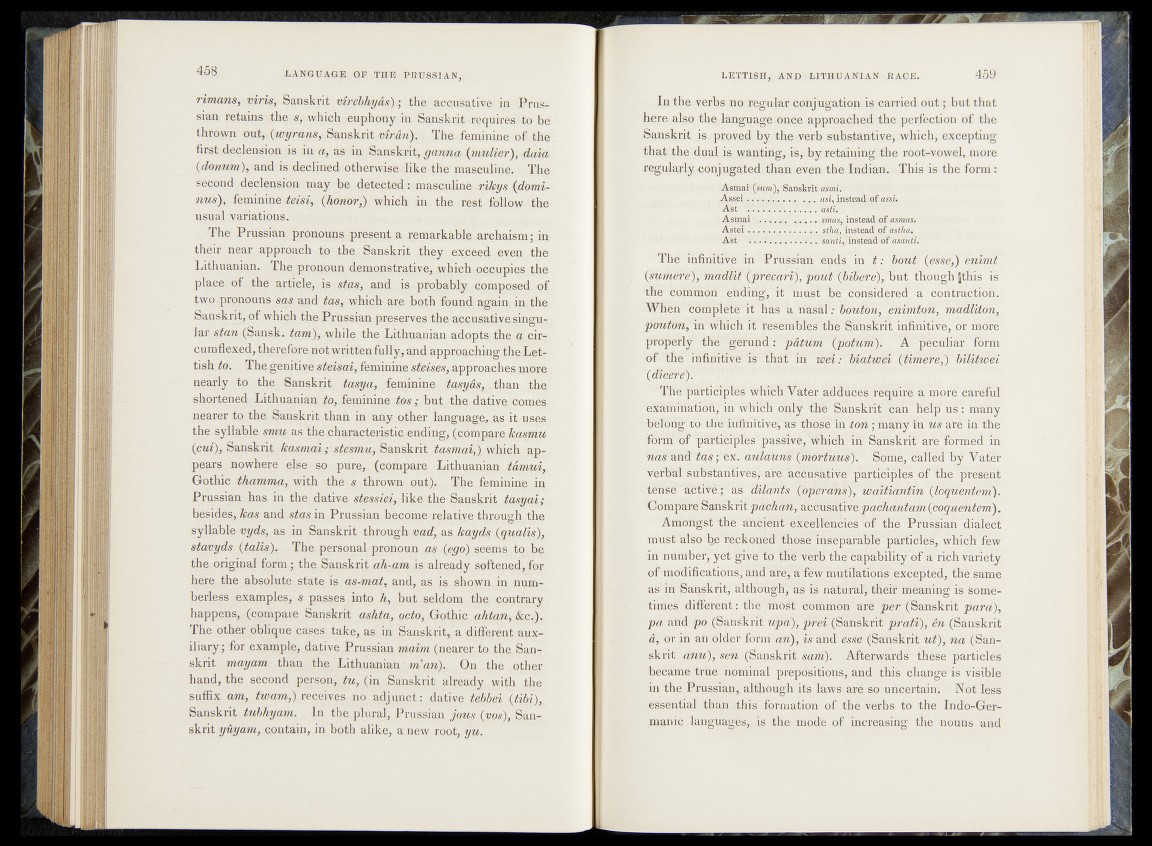
rimans, viris, Sanskrit virebhyas) ; the.» accusatiyedn Prussian
» retains the s, whiehjeuphony in Sanskrit,Requiresrto be
thrown out, (wyruns, Sanskrit viran). The feminine p f the
first ^ p i ^ ^ | i ^ i n ;ia, ^ f in »Sanskrit, ganna (mutter)) daia
(donum)) and isldeclined otherwise like the »masculi®e$i| The.
second declension may be detectedmasculine rifcys (domi-
rius), feminine teisi, (honor,) which in the rest follow the
usual variations.
The Prussian pronouns present a remarkable archaism; in
their near approach to the Sanskrit they exceed, eyen the
Lithuanian. The. pronoundemonstrati.ve, which occupies the
place of the article, is stas, and is probably composed of
turn .pronouns sas and tas, which are both found again. ;ijp|b § 4
Sanskrit, of which the Prussian preserves the accusatlvasingUT
Jar sfen (Sansk. tam)y while the Lithuanian adopts, the, ^ c ir-
cumflexed, therefore.not written fully, and approaching the^et-
tish to. The genitive steisai, feminine: steises, approaches more^
nearly to the Sanskrit tasya, feminine tasyas, J;han the
shortened Lithuanian £o,.feminine tos; but .the dative cqmes.
nearer to the Sanskrit than in. any other language,.as it yses(
the syllable smu as the characteristic ending, (porppare Jcasmu
(cui), Sanskrit kasmai; stesmu, Sanskrit tasmai,-) v ^jck appears
nowhere else s o , pure, (compare Lithuanian tarqui,
Gothic thamma, with the s thrown out). The .feminine in
Prussian has in the dative stessiei,' like “the Sanskrit, tgsyqij
besides, kas and sta sin Prussian become, relative tli^ouffK the
syllable vyds, as in Sanskrit through vad, as kapds (quqlis\,
stavyds (tatts). The personal pronoun as (ego) seems,;to be,
the original form; the Sanskrit ah-am is already softened,for
here the absolute state is as-mat, and, as is shown in numberless
examples, s passes into h, but seldom the contrary
happens, (compare Sanskrit ashta,octo, Gothic ahtan, &c).
The other oblique cases take, as in Sanskrit, a different auxiliary
; for example, dative Prussian ytqim (nearer to. the Sanskrit
mayam than the Lithuanian m’qn)s„ On the .other
hand, the second p e r s o n , ( i n Sanskri to already with the
suffix am, twam,) receives no adjunct: dutxwe tehbei (tipi),
Sanskrit tuhhyam_. In the plural, Prussian joup ( vqs), Sanskrit
yfiyam, contain, in both alike, a new root, yu.
„ In ^rqnyerbs^hOK'jegular- ep&jugatiom %carried out 5 but that
here .^lj^^hef la n g u 'a g e a p p r o a c h e d ; the perfection of the
Sanskrit is v pro^edtbyvthe'ver V,substantive j which, excepting
fk|^iihe-'duaLi^wanting/|.i^)^ky retaining the riot-vowel, more
regularly,jconjugaledsthanlev.en the. Indian. This is the form:
Assei. . . . . . . . . . . . . ast, ^n^tcatLof jg!
Ast I ..
Asmai ................... •. iW^-insteaiVof'flsmas.'-,
Abtei . . . . . . . . . ^ I of dtl/t«'. ..
■ Ast'1 . . . 1 ................. sfi^‘^instraa,''OT*^«!/Ui.*
T h e f In ffifM v e ^m " 4 >r u ^ a h ' ‘^ h ( l s in t : 1 bout)Q^Tf enimt
(ifylmW&f, ^ n d d tt^ y ^ ^ r i% p o u tx n am r ^ , but c c ^ » h |this T y
a contiaction.
Whenweomplete' it masfla nas^voo^^ral^nrmtow, maaliton,
pbutdh) irr which it; T^emules ’tne lnfinitweftoi' more
prbperl^ th n ^ g re n d i^patiim* (potumf. "'A^^ ^uliar form
of-nffre^mfininvl^K^fnat ’in'Kwei s’ Maiwei bilmbei
Thg"Mrftc 1 nlrarwtilchTafer addufpfpp^ri'uf^a mpr^carelul
’e^aknin^^^m^wbich or|ly can lielp uv: many
.bm'Bh g u y | ^ iWfi n itiveOTs ’ those in ton ■ n i a n ^m w i S 'ih * the
form of ^paMcipTeypks^ve., which »^Sanskrif areTrormeo m
’h a s and ta s ; I se tiulauns called Dy^ater
tyefbal 'sdWtafi’t i ^ ^ ^ r e accusative pa^mnjup' of’ the present
fensd1' active; as d ild n ts ^ q ^ r ^ s jf^w a itia n ttn (wqueniem).
vdihpS,fe Sanskrit pdchdW, ^ ^ ^m iv e ^pachdntarn 06mieniem).
’ ‘^morigst the aficienf^S^ilencies Jof”the F^psian dialect
must also kc?eckolied tn b s e ^ q p a ra b le J partimel, which few
in number', ‘yef'jpve to tne vefB tn^rapab^ilify of a riefi variety
of modificatTdna/ahd' are, a few^^latmnstei^cepted^ the same
as*in Sanskrit,'although, as is naturalj their meaning issome-
times different: the^fh'blP^c^hffion are per (Sanskrit para%
pa and po (Sanskrit upa), prei (Sanskrit p'rati), en (Sanskrit
a, 6v in an older form an), is arid ess& (‘Mliskrit ui)\ na (Sanskrit
anu), sen“ (Sanskrit, sqm).\ » Afterwards these particles
became true nominal' Repositions ƒ and this change is visible
in the Prussian, although its laws4are so uncertain. '»Not,less
essential than ithiS';formation' of the verbs to the. Indo-Ger-
manic languages, tls' the modd of increasing1 the nouns and